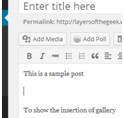What is an XML Sitemap? How to Create a WordPress Sitemap
In the early days of the web, many sites had a tab labeled ‘sitemap’. Clicking on this tab redirected the users to a site that listed all the pages of that website. Traditionally, these sitemaps had been made in HTML; from there, the whole concept evolved greatly, now these sitemaps are made and published in XML, which makes it easy for the search engines to perform a huge variety of tasks. Not many sites use sitemaps now but it proves to be very useful. Now that WordPress powers more than 71% of the world’s websites, you need to know what it is. This article will describe in detail what a WordPress Sitemap is and how you can make use of it.
WordPress XML Sitemap
As discussed, a sitemap lists the pages that are accessible by the visitors. Rather than telling the people about the pages on their website, XML sitemaps allow the admins to make the most of Search Engine Optimization. WordPress XML sitemaps are great for this purpose; they let the search engines know of the pages that are more frequently updated when compared to the others. Not that these sitemaps help boost the ranking of your web pages; they are so to allow better crawling of your website through proper indexing.
The need for a sitemap
As discussed, a WordPress XML sitemap is very important for Search Engine Optimization. Regardless, it does not have any effect on the rankings of your pages. However, it helps in the indexing of a page (if it has not been indexed before). WordPress XML Sitemaps let the search engines know about that page and then they index it properly.
Having a sitemap is very crucial for newly published blogs and websites. The reason behind it all is that new sites do not have many backlinks to each one of their individual posts; therefore, the search engines face a huge problem while indexing them. Having a sitemap facilitates the search engines that crawl the websites more efficiently, discovering all of your posts and pages.
For the more busy websites, sitemaps let the search engines know which part is updated regularly. This will help improve the visibility of the whole website. Allowing search engines to better crawl the websites.
How to create a WordPress XML sitemap
 There are a lot of ways to create a WordPress XML Sitemap. Of course, you can have the whole plug-in business at your disposal creating a sitemap in a matter of some clicks. One such plug-in is the Yoast’s WordPress SEO Plug-in. It is a great one and it comes with a thorough documentation, facilitating the user a whole lot. Using this plug-in optimizes all the blog posts and offers many other great features. Not only that but it also offers custom sitemaps.
There are a lot of ways to create a WordPress XML Sitemap. Of course, you can have the whole plug-in business at your disposal creating a sitemap in a matter of some clicks. One such plug-in is the Yoast’s WordPress SEO Plug-in. It is a great one and it comes with a thorough documentation, facilitating the user a whole lot. Using this plug-in optimizes all the blog posts and offers many other great features. Not only that but it also offers custom sitemaps.
Using it is fairly simple. To start off, you should know that there is no native WordPress XML Sitemap functionality. You will have to install the plug-in, and then turn it on. Following that, you need to go to the plug-in settings; from there, turn the SEO switch on. You just have to check the checkbox. Doing so will enable the sitemap functionality for the WordPress site.
When you check the box; the plug-in displays a number of configuration options for the sitemap. If you do not know how to configure it properly, then ignore all the options and just click on Save Settings. Do not try anything you do not know about; it might mess up your website and have you spending hours after countless hours trying to figure out the main issue. Now after taking care of the options, click on the Save Settings button.
Now your sitemap has been generated. You can view it easily and you won’t have any issues. It is not that this is the only plug-in on the marketplace; there are thousands of plug-ins out there, with the number of downloads in thousands. You can look around, try all of them and see which one suits you best.
After this, you will not have to worry about the visibility of the website. Search Engines will do their magic and you will just have to keep updating the website regularly.

